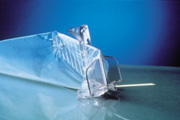Adhesive System Ends Stress Cracking in Catheter Assembly

The manufacturer was dissatisfied with the process used to bond the stainless steel needle halves to lightly tinted polycarbonate wings. A “solvent cocktail,” made by combining a plastic, such as PVC pellets, and adding solvent, to make “glue,” was being used. Formulation inconsistency, stress cracking and toxic solvent fumes were growing concerns.
The solution, Loctite® 3211 medical device adhesive, was specified along with a Loctite® light-cure chamber. The combination proved superior in every way — eliminating stress cracking while reducing rejects due to the solvent cocktail’s inconsistencies.
Typical Applications
Loctite 3211 is primarily designed for bonding polycarbonate to itself, while not inducing stress cracking under typical molded-in stress levels. Its flexibility enhances the load-bearing and shock-absorbing characteristics of the bond area. The adhesive has also shown excellent adhesion to a wide variety of substrates including glass, many plastics and most metals.
Typical Curing Performance
Loctite 3211 is a one-component, thixotropic adhesive that cures rapidly to form flexible, transparent bonds when exposed to ultraviolet radiation and/or visible light of sufficient intensity. The cure rate and ultimate depth of cure will depend on light intensity, the spectral distribution of light source, exposure time and light transmittance of the substrates.
Additional information on Loctite 3211 and the Loctite light-cure chamber is available from Loctite Corp., 1001 Trout Brook Crossing, Rocky Hill, CT 06067-3910; telephone 860-571-5100; fax 860-571-5465; or visit the Web site www.loctite.com
Sidebar: The Benefits of Light-Cure Technology
The many benefits of light-cure adhesives and curing systems make them ideal for assembly operations that require fast processing speeds and low-cost, reliable bonds. They provide:Speed of Cure — With typical cure times from 2 to 60 seconds, manufacturers can dramatically increase throughput, reduce in-process inventories and lower overall processing costs.
Structural Bonds — High-strength bonds may be achieved.
Substrate Versatility — The latest advances in light-cure technology allow manufacturers to bond even a wider range of substrates than before, including plastics containing UV blocking agents, as well as difficult substrates such as polypropylene and polyethylene.
In-line Quality Assurance — Instant cures allow for 100% in-line inspection, eliminating costly off-line quality checks.
Solvent-Free Formulations — for a safer work environment.
Cure on Command — allows time to align parts precisely prior to cure.
Minimal Space and Energy Requirements — Unlike heat-cure epoxies that require large thermal ovens that are expensive to operate, light-cure systems require little space and consume minimal energy.
Easy to Automate — Fully automated dispensing and curing equipment is available to support most any production requirement.
Looking for a reprint of this article?
From high-res PDFs to custom plaques, order your copy today!







